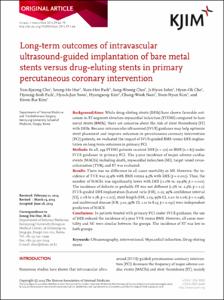KUMEL Repository
1. Journal Papers (연구논문)
1. School of Medicine (의과대학)
Dept. of Internal Medicine (내과학)
Long-term outcomes of intravascular ultrasound-guided implantaion of bare metal stents versus drug-eluting stents in primary percutaneous coronary intervention
- Keimyung Author(s)
- Cho, Yun Kyeong; Hur, Seung Ho; Park, Hyoung Seob; Yoon, Hyuck Jun; Kim, Hyung Seop; Nam, Chang Wook; Kim, Yoon Nyun; Kim, Kwon Bae; Park, Nam Hee
- Journal Title
- Korean Journal of Internal Medicine
- Issued Date
- 2014
- Volume
- 29
- Issue
- 1
- Abstract
- Background/Aims: While drug-eluting stents (DESs) have shown favorable outcomes in ST‑segment elevation myocardial infarction (STEMI) compared to bare metal stents (BMSs), there are concerns about the risk of stent thrombosis (ST) with DESs. Because intravascular ultrasound (IVUS) guidance may help optimize stent placement and improve outcomes in percutaneous coronary intervention (PCI) patients, we evaluated the impact of IVUS-guided BMS versus DES implantation on long-term outcomes in primary PCI. Methods: In all, 239 STEMI patients received DES (n = 172) or BMS (n = 67) under IVUS guidance in primary PCI. The 3-year incidence of major adverse cardiac events (MACEs) including death, myocardial infarction (MI), target vessel revascularization (TVR), and ST was evaluated. Results: There was no difference in all cause mortality or MI. However, the incidence of TVR was 23.9% with BMS versus 9.3% with DES (p = 0.005). Thus, the number of MACEs was significantly lower with DES (11.0% vs. 29.9%; p = 0.001). The incidence of definite or probable ST was not different (1.5% vs. 2.3%; p = 1.0).
IVUS-guided DES implantation (hazard ratio [HR], 0.25; 95% confidence interval [CI], 0.08 to 0.78; p = 0.017), stent length (HR, 1.03; 95% CI, 1.00 to 1.06; p = 0.046), and multivessel disease (HR, 3.01; 95% CI, 1.11 to 8.15; p = 0.030) were independent predictors of MACE. Conclusions: In patients treated with primary PCI under IVUS guidance, the use of DES reduced the incidence of 3-year TVR versus BMS. However, all cause mortality and MI were similar between the groups. The incidence of ST was low in both groups.
- Publisher
- School of Medicine
- Citation
- Yun-Kyeong Cho et al. (2014). Long-term outcomes of intravascular ultrasound-guided implantaion of bare metal stents versus drug-eluting stents in primary percutaneous coronary intervention. Korean Journal of Internal Medicine, 29(1), 66–75. doi: 10.3904/kjim.2014.29.1.66
- Type
- Article
- ISSN
- 1226-3303
- 파일 목록
-
-
Download
 oak-aaa-03346.pdf
기타 데이터 / 223.04 kB / Adobe PDF
oak-aaa-03346.pdf
기타 데이터 / 223.04 kB / Adobe PDF
-
Items in Repository are protected by copyright, with all rights reserved, unless otherwise indicated.